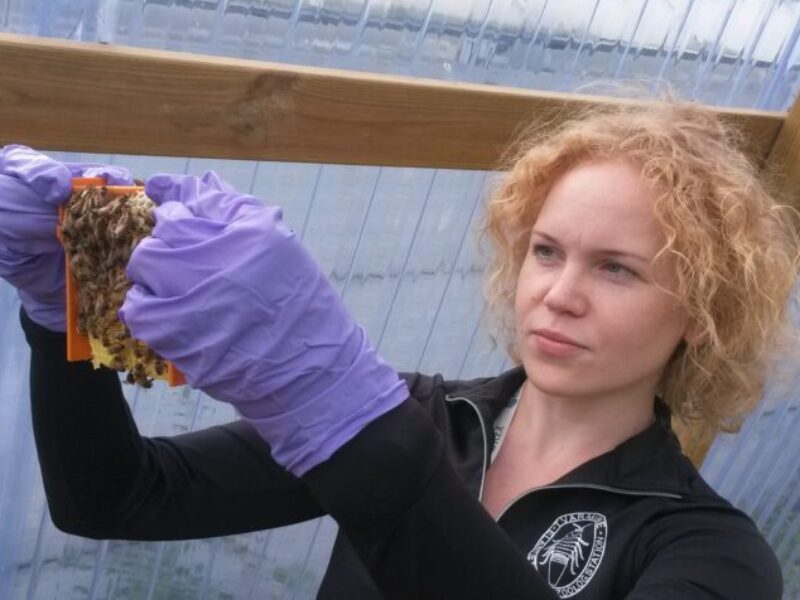
The temperature crept tentatively into the low 50s last week, yet no honeybee poop awaited me on my car’s windshield. For most people that would be a good thing, I guess — few see bug poop as a positive — but for me it’s just a reminder that all four of the hives I had buzzing along last summer are gone. It’s very depressing.
My honeybee guru, Chris Kelly, assures me that it’s entirely my fault for not doing the recommended checks for varroa mites, and I’m sure he’s right. In my defense, though, shaking 100 or so perfectly innocent bees to death in alcohol so that I can see if they’re carrying a dangerous mite load seems cruel. And that’s 100 bees from each hive! I know, I’m sacrificing 100 bees to save a hive of maybe 40,000, but I’m also pretty sure that the 100 who get chosen to drown in alcohol won’t see the upside. But I promised him I would do better, and I will. This year I will do the mite test like a good beekeeper and see if the outcome is any better.
And my bad beekeeping and mites aren’t even the only hazards honeybees are facing, as most of you know. Toxic pesticides, tracheal mites, wax moths and climate change are just some of the other challenges our little striped heroes are battling. But at least we recently had some good news. The New York Times reported in January that Dalan Animal Health, a biotech company in Georgia, received conditional approval from the U.S. Department of Agriculture for a vaccine to protect honeybees from American foulbrood (AFB), a nasty bacterium that can spread quickly from hive to hive and wipe out a beekeeper’s entire livelihood.
While AFB isn’t as widespread of a menace to the honeybee population at large as varroa mites, it is a nightmare for beekeepers who have to deal with it. The microscopic killer settles into the hive’s larvae, turning the hive brown as the larvae die, and causing it to emit a seriously unpleasant odor — hence the name “foulbrood.”
The only way to eliminate foulbrood from an infected hive is to destroy all the hive components. For a commercial beekeeper with perhaps dozens of hives in close proximity to one another, there’s a good chance that if one hive has the bacteria, its neighbors do too. Since AFB spores can survive for up to 70 years, beehives contaminated with it should be incinerated to ensure that no spores are left viable — an expensive proposition since all those hives have to now be replaced, as do the colonies that inhabited them.
And it’s not just the hive components that are a risk. The tools beekeepers use to manage those hives, like brushes and the metal multipurpose hive tool, are often how foulbrood spreads. A beekeeper works in one hive, not noticing the early stages of foulbrood as she uses the hive tool to pry out frames stuck together by propolis, the sticky glue bees make from nectar. She uses that same tool on the rest of her hives, and just like that, an entire bee yard can be doomed.
So the vaccine is definitely good news. Even better news is that it isn’t delivered like a measles vaccine — beekeepers don’t have to inject a teeny little needle into each bee to administer the vaccine. The vaccine, made from dead cells of the evil bacterium, is incorporated into “queen candy,” a sugary concoction that looks like a piece of white candy.
Honeybee breeders place each queen in a small cage with a piece of queen candy. The cage also contains several worker bees, whose job it is to feed the queen. The workers eat the queen candy containing the vaccine. They digest the candy and transfer both the nutrients from it — and the vaccine — to the glands in their heads that produce royal jelly, which is what the workers feed the queen throughout her life. The vaccine finds its way to the queen’s ovaries, and the vaccine is transferred to the developing eggs, giving the larvae that hatch from those eggs protection against AFB.
Notably, this is the first vaccine approved for use in honeybees anywhere in the world, and the first approved for use in an insect in the United States. Honeybees are essential to the health of so much of our food supply, from almonds to pumpkins. One out of every three bites Americans put in their mouths is the result of honeybee pollination. And while this new vaccine won’t solve the myriad problems honeybees face, it is a big step in the right direction — one that might ensure more bee poop on more windshields in the years ahead.